Hudson Valley
| Part of a series on |
| Regions of New York |
|---|
 |
|
Timelines of town creation
|
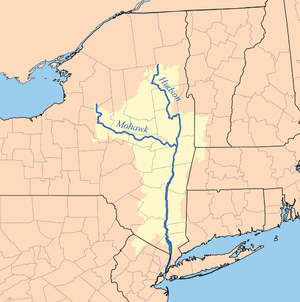
The Hudson Valley comprises the valley of the Hudson River and its adjacent communities in the U.S. state of New York, from the cities of Albany and Troy southward to Yonkers in Westchester County.[1]
Geology and physiography
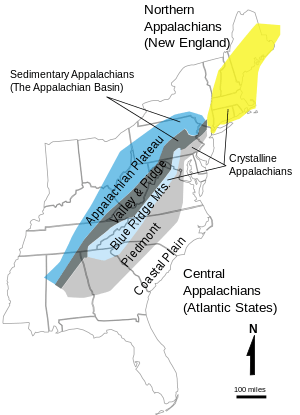
The Hudson River valley runs more or less north to south down the eastern edge of New York State, cutting through a series of rock types including Triassic sandstones and redbeds in the south and much more ancient Precambrian gneiss in the north (and east). In the Hudson Highlands, the river enters a fjord cut during previous ice ages. To the west lie the extensive Appalachian highlands. In the Tappan Zee region, the west side of the river has high cliffs produced by an erosion-resistant diabase; these cliffs range from 400–800 feet in height.[2]
The Hudson Valley is one physiographic section of the larger Ridge-and-Valley province, which in turn is part of the larger Appalachian physiographic division.[3] The northern portions of the Hudson Valley fall within the Eastern Great Lakes and Hudson Lowlands Ecoregion.
During the last ice age, the valley was filled by a large glacier that pushed down as far as Long Island. Near the end of the last ice age, the Great Lakes drained south down the Hudson River, from a large glacial lake called Lake Iroquois.[4] Lake Ontario is the remnant of that Lake. Large sand deposits remain from where Lake Iroquois drained into the Hudson; these are now part of the Rome Sand Plains.
History
Colonial era
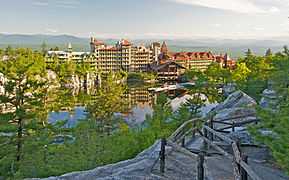
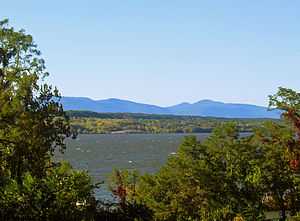

At the time of the arrival of the first Europeans in the 17th century, the area of Hudson Valley was inhabited primarily by the Algonquian-speaking Mahican and Lenape Native American peoples,[6][7] known collectively as River Indians.[8]
The first Dutch settlement was in the 1610s with the establishment of Fort Nassau, a trading post (factorij) south of modern-day Albany, with the purpose of exchanging European goods for beaver pelts. Fort Nassau was later replaced by Fort Orange. During the rest of the 17th century, the Hudson Valley formed the heart of the New Netherland colony operations, with the New Amsterdam settlement on Manhattan serving as a post for supplies and defense of the upriver operations.[9]
During the French and Indian War in the 1750s, the northern end of the valley became the bulwark of the British defense against French invasion from Canada via Lake Champlain.[10]
The valley became one of the major regions of conflict during the American Revolution. Part of the early strategy of the British was to sever the colonies in two by maintaining control of the river.[11]
19th century
Following the building of the Erie Canal, the area became an important industrial center. The canal opened the Hudson Valley and New York City to commerce with the Midwest and Great Lakes regions.[12] However, in the mid 20th century, many of the industrial towns went into decline.[13]
In the early 19th century, popularized by the stories of Washington Irving, the Hudson Valley gained a reputation as a somewhat gothic region inhabited by the remnants of the early days of the Dutch colonization of New York (see, e.g., The Legend of Sleepy Hollow). The area is associated with the Hudson River School, a group of American Romantic painters who worked from about 1830 to 1870.[14]
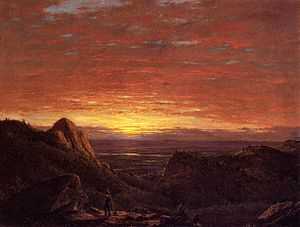
The natural beauty of the Hudson Valley has earned the Hudson River the nickname "America's Rhineland",[15][16] a comparison to the famous 40 mile (65 km) stretch of Germany's Rhine River valley between the cities of Bingen and Koblenz. A similar 30-mile (48 km) stretch of the east bank in Dutchess and Columbia counties has been designated a National Historic Landmark.
Tourism became a major industry as early as 1810, as elite visitors frequented the mineral water at Ballston Spa and Saratoga Springs for their health. With convenient steamboat connections in New York City, and numerous attractive hotels in romantic settings, tourism became an important industry. Early guidebooks providing suggestions on their itinerary. Middle class people who read James Fenimore Cooper's novels, or saw the paintings of the Hudson River School, were especially attracted.[17]
Pollution of the Hudson River
The most discussed pollution of the Hudson River is General Electric's contamination of the river with Polychlorinated biphenyls (PCBs) between 1947-77.[18] This pollution caused a range of harmful effects to wildlife and people who eat fish from the river or drink the water.[18] In response to this contamination, activists protested in various ways. Musician Pete Seeger founded the Hudson River Sloop Clearwater and the Clearwater Festival to draw attention to the problem. The activism led to the site being designated as one of the superfund sites.[19] Other kinds of pollution, including mercury contamination and sewage dumping, have caused problems also.[20][21]
Various responses to pollution are proposed and debated.
Regions
The Hudson Valley is divided into three regions: Lower, Middle, and Upper. The following is a list of the counties within the Hudson Valley sorted by region.[22] The Lower & Mid Hudson Valley is typically considered part of the Downstate New York region due to its geographical and cultural proximity to New York City
|
Lower Hudson |
Mid-Hudson |
Upper Hudson/Capital District |
Communities
Sports
The Hudson Valley Renegades is a minor league baseball team affiliated with the Tampa Bay Rays. The team is a member of the New York - Penn League and plays at Dutchess Stadium in Fishkill. The Rockland Boulders of the independent Can-Am League play in Rockland County.
See also
References
- ↑ "Mountains, Valleys and the Hudson River". Hudson Valley Tourism. 2009. Retrieved 2011-09-29.
- ↑ Van Diver, B.B. 1985. Roadside Geology of New York. Mountain Press, Missoula. p. 59-63.
- ↑ "Physiographic divisions of the conterminous U. S.". U.S. Geological Survey. Retrieved 2007-12-06.
- ↑ Eyles, N. Ontario Rocks: Three Billion Years of Environmental Change. Fitzhenry & Whiteside, Markham, Ontario. 339 p.
- ↑ "National Historic Landmarks Program - Lake Mohonk Mountain House". National Park Service. Retrieved 2012-09-03.
- ↑ Ruttenberg, Edward Manning (1872). History of the Indian tribes of Hudson's River: Their Origin, Manners and Customs, Tribal and Sub-tribal Organizations, Wars, Treaties, etc. Albany, NY: J. Munsell. OCLC 85801464.
- ↑ Wermuth, Thomas S.; Johnson, James M.; Pryslopski, Christopher, eds. (2009). America's first river: the history and culture of the Hudson River Valley. State University of New York Press. ISBN 978-0-615-30829-6.
- ↑ Dunn, Shirley W. (2009). The River Indians – Mohicans Making History. Purple Mountain Press. ISBN 978-0-916346-78-2.
- ↑ Gehring, Charles T.; Starna, William A., "Dutch and Indians in the Hudson Valley: The Early Period". Wermuth et al., pp. 13–29.
- ↑ Thomas, A and Smith, P; Upstate down: thinking about New York and its discontents University Press of America 2009, p78
- ↑ Glatthaar, Joseph T., and Martin, James Kirby (2007). Forgotten Allies: The Oneida Indians and the American Revolution, p. 39. Macmillan. ISBN 0-8090-4600-8.
- ↑ Stanne, Stephen P., et al. (1996). The Hudson: An Illustrated Guide to the Living River, p. 120. Rutgers University Press. ISBN 0-8135-2271-4.
- ↑ Hirschl, Thomas A.; Heaton, Tim B. (1999). New York State in the 21st Century. Greenwood Publishing Group. pp. 126–128. ISBN 0-275-96339-X.
- ↑ Dunwell, Francis F. (2008). The Hudson: America's river. Columbia University Press. p. 100. ISBN 978-0-231-13641-9.
- ↑ Collins, Clay (2011-01-01). "Venison juniper berry marinade". The Christian Science Monitor. Retrieved 2011-09-29.
Christmas at my German in-laws’ house in New York’s Hudson Valley – America’s Rhineland – means goose, red cabbage, and klösse (potato dumplings).
- ↑ "Grapes of the Hudson Valley". Hudson Valley Wine Magazine. Retrieved 2011-09-29.
The Hudson Valley’s beautiful river, shorelines and mountains have led some to call our valley ‘America’s Rhineland.’
- ↑ Richard H. Gassan, The Birth of American Tourism: New York, the Hudson Valley, and American Culture, 1790-1835 (2008)
- ↑ 18.0 18.1 "Hudson River PCBs — Background and Site Information". United States Environmental Protection Agency. Retrieved 2007-12-31.
- ↑ Harrington, Gerry (2014-01-31). "Movement afoot to name bridge after Pete Seeger". United Press International. Retrieved 2014-02-03.
- ↑ Levinton, J.S.; Ochron, S.T.P. (2008). "Temporal and geographic trends in mercury concentrations in muscle tissue in five species of hudson river, USA, fish". Environmental Toxicology and Chemistry 27 (8): 1691–1697. doi:10.1897/07-438.1. PMID 18266478.
- ↑ New York State Department of Environmental Conservation (NYSDEC). Albany, NY. (2007). "Hudson River Estuary Program: Cleaning the river: Improving water quality" (PDF). p. 24. Archived from the original (PDF) on 2008-02-27. Retrieved 2007-12-31.
- ↑ Silverman, B et al; Frommer's New York State Frommer's 2009, p196
Further reading
- Donaldson Eberlein, Harold; Van Dyke Hubbard, Cortlandt (1942). Historic houses of the Hudson valley. New York: Architectural Book Pub. Co. OCLC 3444265.
- Scheltema, Gajus and Westerhuijs, Heleen (eds.),Exploring Historic Dutch New York. Museum of the City of New York/Dover Publications, New York (2011). ISBN 978-0-486-48637-6
- Historic Hudson Valley (1991). Visions of Washington Irving: Selected Works From the Collections of Historic Hudson Valley. Tarrytown, NY: Historic Hudson Valley. ISBN 978-0-912882-99-4.
- Hudson Valley Health Systems Agency (1993). Health Maintenance Organizations in the Hudson Valley Region. Tuxedo, NY: Hudson Valley Health Systems Agency. OCLC 30910810.
- McMurry, James; Jones, Jeff (1974). The Catskill Witch and Other Tales of the Hudson Valley. Syracuse, NY: Syracuse University Press. ISBN 978-0-8156-0105-0.
- Mylod, John (1969). Biography of a River: The People and Legends of the Hudson Valley. New York: Hawthorn Books. OCLC 33563.
- Howat, John K. (1972). The Hudson River and Its Painters. New York: Viking Press. ISBN 978-0-670-38558-4.
- Marks, Alfred H. (1973). Literature of the Mid Hudson Valley: A Preliminary Study. New Paltz, NY: Center for Continuing Education, State University College. OCLC 1171631.
- Talbott, Hudson (2009). River of Dreams: The Story of the Hudson River. New York: G. P. Putnam's Sons. ISBN 978-0-399-24521-3.
- Wallkill Valley Publishing Association (1904). The Historic Wallkill and Hudson River Valleys. Walden, NY: Wallkill Valley Publishing Association. OCLC 13418978.
- Wharton, Edith (1929). Hudson River Bracketed. New York: D. Appleton & Company. OCLC 297188.
- Wilkinson Reynolds, Helen (1965). Dutch houses in the Hudson Valley before 1776. New York: Dover Publications. OCLC 513732.
External links
| Wikivoyage has a travel guide for Hudson Valley. |
- Hudson Valley Directory
- Hudson River Valley National Heritage Area
- Hudson River Valley Greenway
- Hudson River Valley Heritage: digital collection of historical materials
- Livingston-Svirsky Archive (LiSA)
| |||||||||||||||||||||||||||||||||||||||||||||||||||||||||||||||||||||||||||||||||||||||||||||||||||||||||||||||||||
| ||||||||||||||||||||||||||||

